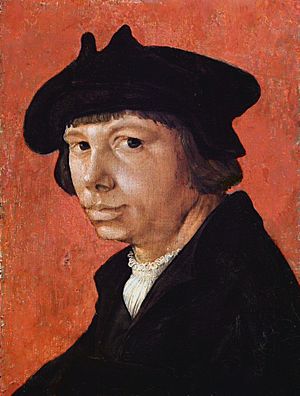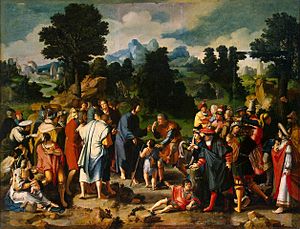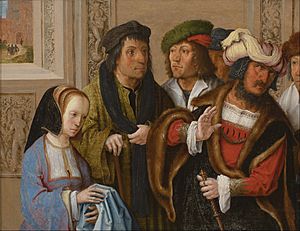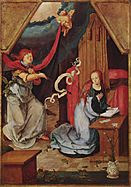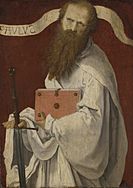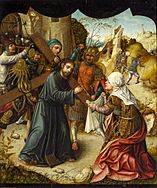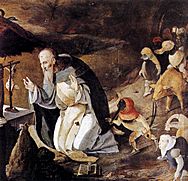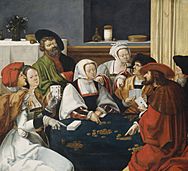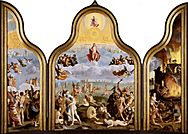Lucas van Leyden facts for kids
Lucas van Leyden (born 1494 – died August 8, 1533) was a famous Dutch painter and printmaker. He was also known as Lucas Hugensz or Lucas Jacobsz. He created art using techniques like engraving and woodcut. Lucas was one of the first Dutch artists to paint everyday scenes, known as genre painting. He was also a very skilled engraver.
Lucas was the son of a painter named Huygh Jacobsz. He was born, lived, and died in the city of Leiden in the Netherlands.
A writer named Carel van Mander described Lucas as an artist who never stopped working. Even as a child, he would work late into the night. His mother didn't like this, not just because of the cost of candles, but also because she thought too much studying wasn't good for him. Van Mander said that as a boy, Lucas only spent time with other young artists. These included painters, glass-etchers, and goldsmiths. When he was 12, a nobleman paid him a golden coin for each year of his age for a watercolor painting of St. Hubert.
Contents
Lucas van Leyden's Paintings
Lucas learned basic art skills from his father and from another artist, Cornelis Engelbrechtsz. However, his own unique style developed very early. We don't know where he learned engraving. But he was inspired by the works of Marcantonio Raimondi. Lucas used some of Raimondi's ideas in his own engravings and paintings.
Lucas became very skilled at engraving at a young age. His earliest known print, Mohammed and the Murdered Monk, is from 1508. This means he was only about 14 years old. Yet, this early work already showed great skill and creativity.
Today, we know of 17 paintings that were definitely made by Lucas. Another 27 paintings are known from old descriptions. Some are known from copies made by other artists. Others are known from drawings of them made in the 1600s.
Art experts have described four main periods in Lucas's art journey:
- His early works (around 1506–1512) often showed figures from the waist up.
- Then, he started to develop his landscape paintings (around 1512–1520).
- After that, his art was influenced by paintings from Antwerp (around 1521–1525).
- Finally, his later works (around 1525–1531) showed many figures in outdoor scenes. An example is his painting Healing of the Blind Man of Jericho.
Two other important artists who influenced Lucas were Albrecht Dürer and Jan Gossaert. Lucas was friends with both of them. Dürer even drew a portrait of Lucas when they met in 1521. Dürer was a master of engraving. Gossaert had a "Romanist" style, which meant he was inspired by classical Roman art. Both of these artists greatly influenced Lucas van Leyden's work.
- Lucas van Leyden's works -paintings
-
Annunciation 1522
Lucas van Leyden's Prints
Lucas created many prints, including everyday scenes and famous stories from the Bible. Some of his well-known prints include Adoration of the Magi, The Virgin and Child on the Crescent, and The Holy Family.
The Power of Women Series
Between 1513 and 1517, Lucas made a series of woodcuts called "The Power of Women". This series included two sets of prints, one large and one small. This theme, "The Power of Women", was very popular in art and literature during the Renaissance. These artworks often showed women in charge, which was different from their usual roles at the time.
Large Power of Women (1513)
- The Mouth of Truth: A woman puts her hand into the mouth of a lion statue. A crowd watches her.
- The Fall of Man: Eve gives an apple to Adam from the tree of knowledge. In the background, an angel makes them leave the Garden of Eden.
- Samson and Delilah: Delilah cuts Samson's hair while he sleeps in her lap.
- Solomon's Idolatry: King Solomon kneels before an idol. His mistress and a crowd watch him.
- Herod and Herodias: Herod and Herodias sit at a table. Their daughter Salome brings them a plate with the head of St. John the Baptist.
- The Poet Virgil Suspended in a Basket: Virgil is shown stuck in a basket hanging from a tower. A laughing crowd is below him.
Small Power of Women (1517)
- The Fall of Man: Adam and Eve are near the tree of knowledge. The serpent is wrapped around the tree. Later, an angel makes them leave paradise.
- Jael Killing Sisera: Jael hammers a tent peg into Sisera's ear. She later shows this to a group of soldiers.
- Samson and Delilah: This print is similar to the larger one. Delilah cuts Samson's hair while he sleeps.
- Solomon's Idolatry: This print is also similar to the larger one. King Solomon kneels before an idol, watched by his mistress and a crowd.
- Jezebel Promising Naboth's Vineyards to King Ahab: Jezebel stands next to her husband, King Ahab, who is in bed.
- Herod and Herodias: Salome holds a plate with the head of St. John the Baptist in front of Herod and Herodias. Through a window, St. John the Baptist is seen being beheaded.
- Power of Women Woodcuts
Lucas van Leyden's Family
In 1515, Lucas married Elisabeth van Boschhuysen. She came from a well-known family in Leiden. They did not have any children together. However, Lucas did have a daughter named Marijtje, who was born in Leiden around 1512. Marijtje later married a painter named Dammas Claesz de Hoij. Their family, the De Hoij family, included many important artists throughout the 1500s and 1600s.
Where to See Lucas van Leyden's Art
Today, you can find Lucas van Leyden's artwork in many museums around the world. Some of these include:
- The Metropolitan Museum of Art
- The Museum of Fine Arts, Boston
- The British Museum
- The Princeton University Art Museum
- The Museum Boijmans Van Beuningen
- The Philadelphia Museum of Art
- The Fralin Museum of Art
- The Brooklyn Museum
- The Ashmolean Museum
- The Detroit Institute of Arts
- The Museum of New Zealand Te Papa Tongarewa
- The Worcester Art Museum
- The Clark Art Institute
- The University of Michigan Museum of Art
- The Thyssen-Bornemisza Museum
See also
- Renaissance in the Netherlands
 In Spanish: Lucas van Leyden para niños
In Spanish: Lucas van Leyden para niños


